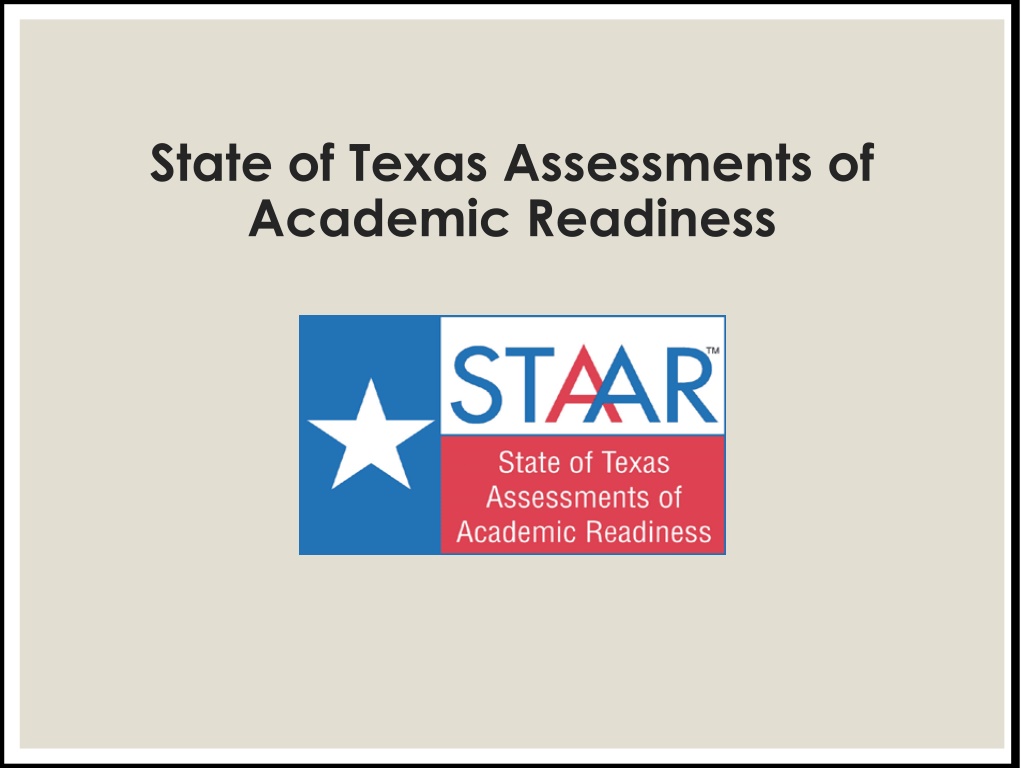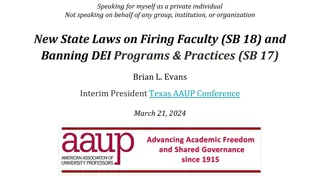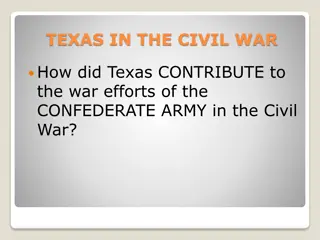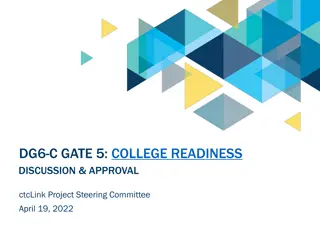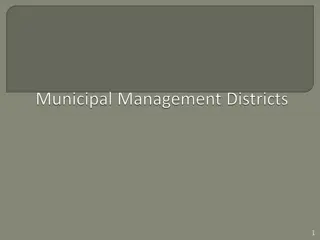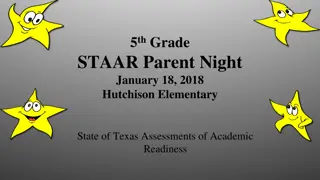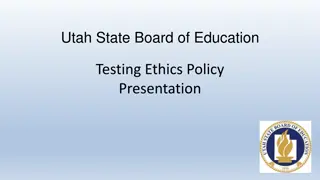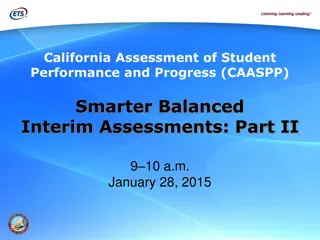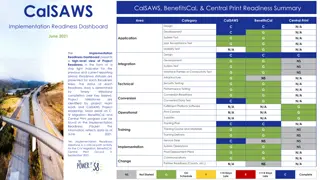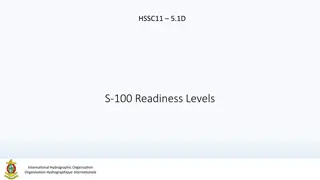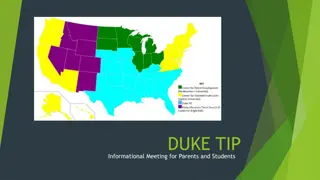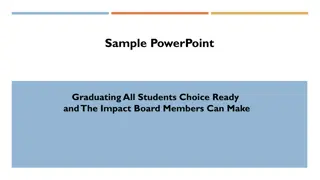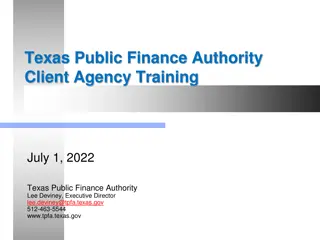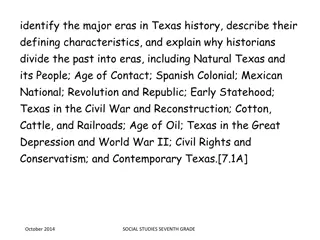Understanding the State of Texas Assessments of Academic Readiness (STAAR)
The State of Texas Assessments of Academic Readiness (STAAR) is a criterion-referenced test that evaluates students based on the Texas Essential Knowledge and Skills (TEKS) curriculum standards. It includes Readiness and Supporting Standards, with specific testing requirements for different grade levels. STAAR tests cover various subjects like Reading, Math, Writing, and Science, aiming to promote students to higher grades based on their performance levels. The testing dates and accountability performance labels provide further insight into this rigorous assessment process.
Download Presentation

Please find below an Image/Link to download the presentation.
The content on the website is provided AS IS for your information and personal use only. It may not be sold, licensed, or shared on other websites without obtaining consent from the author. Download presentation by click this link. If you encounter any issues during the download, it is possible that the publisher has removed the file from their server.
E N D
Presentation Transcript
State of Texas Assessments of Academic Readiness
General Information STAAR is a criterion-referenced test that measures a student s performance in comparison to the curriculum standards, Texas Essential Knowledge and Skills (TEKS), for each subject and grade level.
STAAR Standards Readiness Standards -are essential for success in the current grade or course. -are important for preparedness for the next grade or course. -support college and career readiness. -necessitate in-depth instruction. -address broad and deep ideas. Supporting Standards -may be introduced in the current grade or course. -maybe emphasized in a previous or subsequent year. -may be reinforced in the current grade or course. -play a role in preparing student for the next grade or coarse but not a central role. -address more narrowly defined ideas than Readiness Standards.
STAAR Tests Grade 3 : Reading and Math Grade 4 : Reading, Math, and Writing Grade 5: Reading, Math, and Science 5thgrade students must pass reading and math STAAR to be promoted to 6thgrade. Only 5thgrade students have the opportunity to retest.
Testing Dates April 1st: 5thGrade Math & 4thGrade Writing (Day 1) April 2nd: 5thGrade Reading & 4thGrade Writing (Day 2) April 22nd: 3rdand 4thGrade Reading April 23rd : 3rdand 4thGrade Math & 5thGrade Science Each testing session is 4 hours.
Accountability Performance Labels Level III: Advanced Academic Performance Level II : Satisfactory Academic Performance Level I: Unsatisfactory Academic Performance **Emphasis is on College and Career Readiness.
READING STAAR
Reading STAAR Examples- See packet.
STAAR is Rigorous! The reading passages are long. Questions are complex and require deep thinking. 3rdgrade students read 4-5 selections. Possible 48 questions 3rdgrade students are required to read, comprehend, and analyze up to a maximum 3,400 words in 4 hours.
STAAR is Rigorous! 4thand 5thgrade students read 3 or 4 single selections and a paired selection. Possible 52 questions in 4thgrade. Possible 54 questions in 5thgrade. 4thand 5thgrade students are required to read, comprehend , and analyze up to 4,000 words in 4 hours.
Genres Assessed- Literary Students in 3rd, 4th, & 5thgrade are assessed using: Fiction Literary Nonfiction Poetry Drama is added in 4thgrade Media literacy (technology) is embedded throughout the test.
Genres Assessed- Informational Students in 3rd, 4th, & 5th grade are assessed using: Expository Procedural Persuasive is added in 5thgrade Media literacy (technology) is embedded throughout the test.
Paired Selections Strands and genres can be mixed! Literary-Literary Fiction-poetry Literary nonfiction-drama Fiction-literary nonfiction Informational- Informational Expository- expository Expository-persuasive Literary- Informational Fiction-expository Poetry-expository Literary nonfiction-persuasive
Students must be able to analyze a variety of texts, their organizational patterns, and make connections between texts in a logical way. draw conclusions about the interaction of characters and the changes they undergo throughout the text. make complex inferences within and between a variety of text using text evidence. recognize how the structure of the text affects meaning. determine the meaning of unfamiliar and multiple- meaning words using context, prefixes, suffixes, and roots.
Students must be able to understand how the author uses sensory language to create imagery and how figurative language contributes to the meaning. identify the theme, determine the order and importance of the plot s main events. summarize the plot and describe the interaction of characters. identify the author s purpose. use text features to locate information that supports meaning.
How can parents help? Make sure that students read at least 30 minutes daily! Read with your children, have conversations about what they are reading and ask questions. A list of question stems is available to help start reading conversations. Think out loud to help your child understand how to logically think through the information. Make sure that your child does their homework and that they show all work clearly. Make sure your child s work shows clear thinking, as well as the depth of their thinking.
3rd grade math 1. What is the missing number in the number pattern? 2, 6, 10, 14, 18, ___ , 26 a. 20 b. 21 c. 22 d. 24 5th grade math 2. A watermelon weighs 7.8 kilograms, a bag of potatoes weighs 4.1 kilograms, and a large pumpkin weighs 9.7 kilograms. How much do the watermelon and the pumpkin weigh together? a. 1.9 kg b. 11.9 kg c. 17.5 kg d. 21.6 kg
Math STAAR Examples- See packet.
STAAR MATH GRADES 3, 4, & 5 More Rigorous? What does that mean? Uses complex questioning that requires analysis and logical reasoning to understand the task. Multiple-step problems with fewer key word indicators to help determine appropriate strategies. More fill-in griddable questions without answer choices. Computation errors can go undetected. Test is longer and time is limited to 4 hours 3rd Grade - 46 questions + 8 = 54 questions 4th Grade - 48 questions + 8 = 56 questions 5th Grade - 50 questions + 8 = 58 questions * Extra field test questions are added each year which extend the length even more.
STAAR MATH GRADES 3, 4, & 5 What does the test look like? 3rd Grade Question: Luther waited 50 minutes in line to buy tickets to a play. While waiting, Luther played his video game for 12 minutes and read a book for 25 minutes. The rest of the time, Luther talked to his best friend Chuck. How much time did Luther spend talking to Chuck? A. 38 minutes B. 25 minutes C. 37 minutes D. 13 minutes Multistep problem must add 12 + 25, then subtract from 50. Complex question missing an addend, not a sum (12 + 25+ ___ = 50) Logical reasoning - must recognize choices A, B, and C are too large based on context of the problem. If you misunderstand the question, answer A or B could seem reasonable.
STAAR MATH GRADES 3, 4, & 5 What is being tested and what are the expectations? The 3-5 Math Reporting Categories and Student Expectations Numbers and Operations: The student will demonstrate an understanding of numbers, operations, and quantitative reasoning. Patterns and Relationships: The student will demonstrate an understanding of patterns, relationships, and algebraic reasoning. Geometry: The student will demonstrate an understanding of geometry and spatial reasoning. Measurement: The student will demonstrate an understanding of the concepts and uses of measurement. Probability and Statistics (graphs): The student will demonstrate an understanding of probability and statistics. * Underlying Processes and Mathematical Tools concepts are embedded within multi-step problem solving. The students will need to read carefully to identify the appropriate steps.
STAAR MATH GRADES 3, 4, & 5 How Parents Can Help? Help your child memorize multiplication facts- practice with flashcards Encourage your child to show all their work and explain it to you Model your thinking aloud to solve problems and then have your child solve a similar problem Use math vocabulary with your child Make connections to every day math Find online resources (Google specific skills to locate practice) Make your child read EVERYDAY. Good reading skills are essential to understanding STAAR math problems.
How Parents Can Help? (cont.) Ask Your Child Higher Level Questions How would you explain .? Why does this work/not work ? How could you verify ? How would you prove or disprove ? What can you conclude about ? What information lead you to draw this conclusion? Where else could you apply this thinking?
WRITING STAAR
STAAR Writing 4th Grade See packets!
STAAR Writing 4th Grade Two Day Writing Test Day 1 - multiple choice and 1 composition Day 2 - multiple choice and 1 composition Four-hour time limit per day
STAAR Writing 4th Grade Test Components 1. Composition (Narrative & Expository) 2. Revising and Editing (multiple choice: 12-14 questions/day totaling 28 questions)
STAAR Writing -Revising Revision Focus (32% of test/9 items multiple choice) Effectiveness Introduction and conclusion Organization Progression Development Language/Word Choice Sentences
STAAR Writing Editing Editing Focus (68% of test/19 items multiple choice) Correctness Conventions (Spelling, Capitalization, Punctuation)
STAAR Writing - Composition Students will write 2, one-page compositions addressing different types of writing. Personal Narrative: Write about an important personal experience. Expository: Create a brief composition that establishes a central idea in a topic sentence, contains a concluding statement, and includes supporting sentences with simple facts, details, and explanations.
STAAR Writing After completing the multiple choice questions for that day s test, and within the four-hour time limit, a student will be expected to brainstorm his topic, make a graphic organizer for the piece of writing, write the actual composition, then revise and edit his work.
STAAR Writing Composition Scoring Organization and Progression Is the paper written to the prompt? Does the paper maintain focus? Does the writer establish relationships among ideas Development of Ideas -Are examples detailed and well-chosen? -Is the piece engaging and does the writer demonstrate understanding of the task? Use of Language/Conventions -Is the word choice thoughtful, appropriate, and purposeful? -Are the sentences varied and purposeful? -Does the writer demonstrate the use of conventions and is the piece fluent and clear?
SCIENCE STAAR
8th grade science 9. Riders on cattle drives had to watch over the cattle at night. They kept track of their duty time by watching the position of the Little Dipper. The position of these stars changes because of the a. Earth s rotation b. atmosphere s composition c. moon s revolution d. Earth s shape
SCIENCE STAAR 5th Grade See packet.
STAAR Science 44 Multiple Choice Questions + 8 = 52 questions Extensive use of content vocabulary Application of scientific knowledge
STAAR Science Science Scientific Investigation and Reasoning Matter and Energy Force, Motion and Energy Earth and Space Organisms and Environments
How Can Parents Help? Practice science vocabulary at home. Have kids draw diagrams or demonstrate. Encourage discovery. How do you think that happened? What if we changed this? Get on the computer! TONS of science websites.
Its all about ATTITUDE!
EISENHOWER BOOT CAMP For 2 weeks before each STAAR test Theme Intensive Review Lessons Kids grouped differently Quizzes every day Homework every night Lessons focus on strengths and weaknesses of year s data
HOW THE STAAR TESTING WILL GO: Details: Testing Materials: We will provide breakfast as usual. Testing begins ASAP 4 hours to test (unless student is testing in non- native language) Clock stops for lunch, medical breaks, emergencies Bathroom Monitor Lunch Monitor No Specials (PE/Music/Art) Test Booklets Answer Document Mathematics chart Graph paper Extra paper: including post it notes Pencils Highlighters Snack & Water Bottle while testing
WHAT PARENTS CAN DO TO HELP: The Night Before On STAAR Testing Day Visualization: Have a conversation with your child about what the day will look like. Eat a good, healthy breakfast. Do a relaxing activities like taking deep breaths, tensing muscles and then relaxing them, talking about something unrelated to STAAR. Get a good night's sleep. Kids need a full 8 hours of sleep. Self-Talk: give your child a few phrases that can motivate him/her "I just need to do my best!" "I can do it." "Stay cool." Arrive early or on-time to school. Feel free to leave cell phones, backpacks, hand-held games at home. Answer any fears or questions your child might have. Wear layers so your child is comfortable in any temperature. Prepare your child s snacks, pencils, clothes, etc. the night before. Remain calm and positive.
Questions? vonessa.biehl@gpisd.org Vonessa Biehl: Instructional Coach for Eisenhower Elementary
We will be available for any remaining questions. Thanks for attending!
